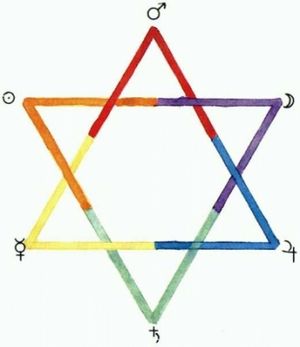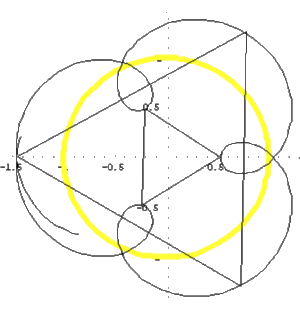Hexagram

The hexagram ✡ (Greek: εξάγραμμος hexágrammos "with six lines") or sexagram (Latin) is a hexagonal star composed of two overlapping equilateral triangles or formed by the diagonals of a regular hexagon. The hexagram is considered a symbol for the macrocosm. In alchemy it is also a sign for the totality of the four elements.
Hexagram exercise
The principle
of Saturn is the physical basis
of the Sun eternal growth, eternal progress
of the Moon holding on, retarding, solidifying
of Mars courage to lead the aggressive into the sensual life, the red blood
of Mercury the leading out of the sensual life
of Jupiter the liberation of the I
of Venus, the absorption in love.
The colours given correspond to these planets and principles respectively[1][2][3]:
The hexagram corresponds to currents in the astral body, but this is not to be understood as a line figure; the double triangle is only an average. (Whereas the currents in the etheric body form the lines of a pentagram, the hexagram represents the astral body in a completely different way, not line-like, but flatly physical). If the figure is turned in its vertical axis, the real figure comes out, even if the horizontal average does not quite correspond to a circle (oval). The horizontal lines therefore actually form a surface; the upper one at the height of the arms, the other at the height of the knees. The triangle pointing downwards has to do with the bodies: the astral body (moon), etheric body (sun), physical body (Saturn principle). The other triangle with the higher parts: Sensation soul (Mars), mind soul (Mercury) and consciousness soul, which is only at the beginning of its development (Jupiter). Accordingly the colours.
One should meditate on these figures and the meaning of their details in order to become aware of one's real inner life and one's relationship to the cosmos. One will then awaken peculiar feelings within oneself.“ (Lit.:GA 264, p. 189ff)
The Mercury hexagram

Mercury has a synodic orbital period of about 116 (exactly 115.88) days. From a geocentric point of view, this results in an approximately equilateral triangle (trigon) in the course of a year if you connect the three points of Mercury's orbit closest to the Earth (3 x 116 = 348, i.e. a little less than a year with rounded 365 days. Another, but larger trigon becomes visible if the points furthest from the earth are connected in the same way. Both triangles together form a hexagram. This cosmic archetype is the basis of many three- or six-fold earthly forms. A typical example is the 3- or 6-rayed symmetry of the Lily family (Liliaceae).
Literature
- Ernst-Michael Kranich: Pflanze und Kosmos, Verlag Freies Geistesleben, Stuttgart 1976
- Walter Bühler: Der Stern der Weisen - Vom Rhythmus der großen Konjunktion Saturn-Jupiter, Verlag Freies Geistesleben, Stuttgart 1982, ISBN 3-7725-0760-3
- Rudolf Steiner: Der Mensch als Zusammenklang des schaffenden, bildenden und gestaltenden Weltenwortes, GA 230 (1993), ISBN 3-7274-2300-5 English: rsarchive.org German: pdf pdf(2) html mobi epub archive.org
- Rudolf Steiner: Zur Geschichte und aus den Inhalten der ersten Abteilung der Esoterischen Schule 1904 bis 1914, GA 264 (1987), ISBN 3-7274-2650-0 English: rsarchive.org German: pdf pdf(2) html mobi epub archive.org
- Rudolf Steiner: Kunst und Kunsterkenntnis, GA 271 (1985), ISBN 3-7274-2712-4 English: rsarchive.org German: pdf pdf(2) html mobi epub archive.org
- Rudolf Steiner: Zeichen und Entwicklung der drei Logoi PDF
 |
References to the work of Rudolf Steiner follow Rudolf Steiner's Collected Works (CW or GA), Rudolf Steiner Verlag, Dornach/Switzerland, unless otherwise stated.
Email: verlag@steinerverlag.com URL: www.steinerverlag.com. Index to the Complete Works of Rudolf Steiner - Aelzina Books A complete list by Volume Number and a full list of known English translations you may also find at Rudolf Steiner's Collected Works Rudolf Steiner Archive - The largest online collection of Rudolf Steiner's books, lectures and articles in English. Rudolf Steiner Audio - Recorded and Read by Dale Brunsvold steinerbooks.org - Anthroposophic Press Inc. (USA) Rudolf Steiner Handbook - Christian Karl's proven standard work for orientation in Rudolf Steiner's Collected Works for free download as PDF. |
References
- ↑ In other contexts, other equivalents are sometimes given: e.g. for eurythmy or on the colour sketch "Man in connection with the planets", which is not to be understood as a contradiction but as an expression of different aspects. See for example lecture Vienna, 1 June 1918 (Lit.:GA 271, p. 165ff).
- ↑ The colour sketch "Man in connection with the planets" shows the following assignment of colours to the planets, ordered from bottom to top according to today's astronomical order: Moon (violet), Venus (orange), Mercury (yellow), Sun (white), Mars (light blue), Jupiter (dark blue), Saturn (violet) (Lit.:GA 230, p. 28ff)
- ↑ For eurythmy the following colour assignment is common: Moon (violet), Mercury (yellow), Venus (green), Sun (white), Mars (red), Jupiter (orange), Saturn (blue)
